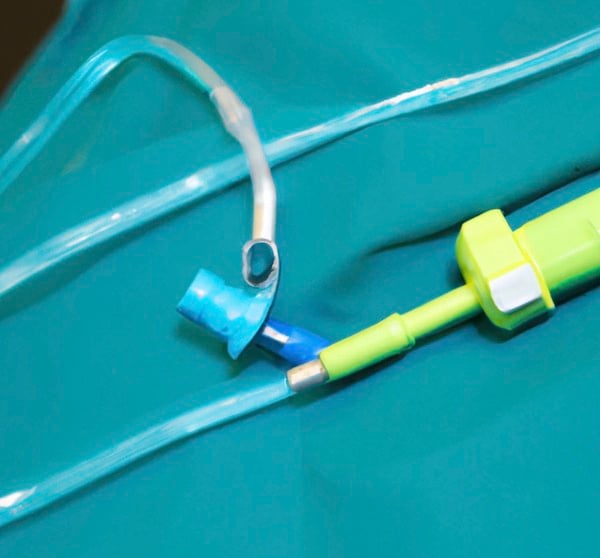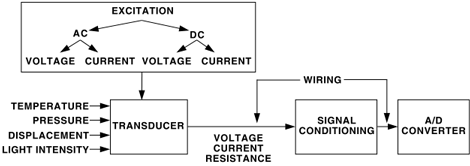Urodynamics testing expands the range of diagnostic data available to urologists. By making it easier to associate numbers with observations, urodynamics enhances the speed, accuracy, and repeatability of common diagnostic procedures.
Urodynamics transducers are a linchpin in the modern realm of data-driven urology practices. But what makes them so essential? Let's explore how these ubiquitous devices work and how urology clinicians put them to good use during urodynamics testing.

Transducer Fundamentals
So what's a transducer? Generally speaking, people use the term to refer to any device that converts one form of energy to another. For instance, ships that rely on sonar use transducers to transform sound waves into measurable electrical signals and vice versa.

Figure 1. Transducer Example
In typical urodynamics applications, we focus on a specific class of transducers known as sensors. In other words, we're concerned with devices that transform a non-electrical physical phenomenon (such as pressure) into an electrical signal.
If you need skilled staff that has a full understanding of urodynamics catheters and transducers - reach out to BHN. We can help you with staffing your urodynamics operations and help you understand the right catheter and transducer configuration for your organization.
Transducers exhibit a variety of behavioral characteristics. Most useful transducers produce a linear response: the varying voltage signal is proportionate to the originating sound pressure waves, temperature fluctuations, pressure, etc. For example, as pressure changes on the transducer the voltage output by the transducer changes proportionately.
Another important quality is the range of inputs a sensor can detect and reliably reproduce, often gauged in magnitude or frequency. As with all electrical devices, transducers are also subject to noise, hysteresis (or history-dependence), and wear.
Another important distinction involves how transducers create their output. Passive devices, such as photodiodes and piezoelectric sensors, produce electricity in response to energy without any external input. Active sensors, on the other hand, require an electrical supply — like a studio microphone that needs a "phantom" power supply to pick up anything. Some transducers are bidirectional: Returning to the sonar example, bidirectional transducers both produce the signal, or ping, and translate the returning echo into a measurable voltage or current.
Transducers in Urodynamics Applications
You may have already guessed how this kind of technology plays a role in urodynamics testing. For instance, a clinician might use a transducer attached to a catheter to measure internal bodily pressures during voiding and other events.
Why are transducers the gold standard of modern practice? While human observation is integral to accurate diagnostics, the reality is that urodynamics catheter transducers bring several game-changing benefits to the table:
- Small size: Transducers can produce accurate data without bulky diagnostic hardware, enhancing the patient experience and minimizing discomfort. This facilitates more regular diagnostic assessments to track conditions over time. Clinicians can even measure multiple data streams simultaneously, like rectum and bladder pressure, to gain a better picture understanding of what's happening.
- Consistency: Individual transducer devices focus on a single phenomenon, such as pressure or temperature, eliminating other contributing factors. While options like urine microscopy and culture are essential, they can't always reveal root causes by themselves.
- Purely quantitative measurements: Transducers produce straightforward numerical representations of pressure and other physical factors. True, these results require interpretation and analysis, but they're less subjective than assessments like "cloudy urine."
Choosing the Right Urodynamics Transducers
As we mentioned above, transducers come in many styles, including active, passive, and bidirectional. But these aren't the only factors that impact their performance.
Efficiency and Transmission Losses
When urodynamics transducers transform pressure into electricity, they lose energy. The same thing happens as electrical signals travel through wires to your monitoring system.
In short, no physical process is 100 percent efficient — which is part of why many transducers are active devices requiring input power. One problem, however, is that amplified or powered systems often introduce additional electrical noise induced by the utility power. A typical solution for this involves signal conditioning, such as filtering and other forms of post-processing that can happen on the fly or during analysis.
Sensitivity and Diagnostic Usage
Another potential issue is that transducers may be more sensitive than required. Just as some statistical models are overfitted, high-sensitivity transducers may pick up minor fluctuations that confound diagnosis — such as the subtle vibrations from a patient shifting or breathing.
High-sensitivity devices can also produce inconsistent readings depending on their placement and use. While post-measurement filtering can help reduce jitter and noise, informed design and engineering choices may produce a similar effect with less effort on the clinician's part.
Common Urodynamics Catheter Transducers
Some types of transducer designs can mitigate these issues — and cause other problems of their own:
Water-perfused urodynamics catheter transducers: These transducers incorporate a continuous column of water that equalizes pressure no matter where the catheter tip ends up. When using these devices, it's critical to zero the system beforehand by equalizing the internal pressure with atmospheric pressure. It's also essential to remember that even though the transducer for this system is external, it must be kept level with the superior border of the symphysis pubis — about where the base of the bladder is — to avoid hydrostatic-induced artifacts in the measurements. If a patient repositions, the clinician must adjust the transducer to match.
Air-charged urodynamics catheter transducers: Here, the transmitting medium is air, and the transducer resides inside the patient's body. This eliminates the gravity-induced hydrostatic pressure inaccuracies seen in water-filled catheters because air is lighter. Air-charged (also known as air-filled) catheters still need zeroing, and they can produce inappropriate damping due to gas compressibility. This dampening can cause less accurate measurements as well.
Microtip catheters: Microtip hardware works without an intermediary transmission medium — a sensor at the tip of the catheter records pressure directly. While their simplicity of design does lend itself to a broad measurement bandwidth and minimal distortion at higher frequencies, these catheters have a drawback: They're costlier and can't be discarded in ordinary waste streams.
All of these designs have their pros and cons. For instance, despite their problems with gravity sensitivity, water-filled catheters are the most studied option, potentially making it easier for clinicians to adopt them quickly.
On the other hand, air-charged catheter transducers overcome many of the issues observed with the water-filled alternative. For instance, they aren't as prone to movement inconsistencies or kinking, and air bubbles are a non-issue. The fact that these systems typically include integrated transducers also decreases operating complexity for clinicians.
The good news is that your practice can do good work with either option — provided you have the appropriate guidance. Studies have shown that for certain types of diagnostics, such as pressure measurement during coughing or Valsalva maneuvers, air-charged and water-perfused urodynamics catheter transducers generated analogous pressures when used simultaneously. Do note, however, that analogous does not mean equivalent, as this deep-dive head-to-head comparison explains:
See full details on video and research here: https://www.ics.org/2019/abstract/518
The most important thing to remember is that with invasive monitoring, the little details make an immense difference. Factors like how you position the patient, how well you zero your devices in advance, and how you interpret the results all matter. For instance, bodies like the International Continence Society publish standardized pressure guidelines, but only for fluid-filled devices. These rubrics don't work with air-charged systems, so you truly need to know how to use your hardware correctly and deal with problems as they arise.
Are you considering switching to a new type of urodynamics transducer — or even a new catheter model within the same general class? If so, you can't afford not to upskill. Your ability to generate good data depends on your understanding of the factors in play, and training is the first step.
If you are in the U.S. and you need help with urodynamics within your practice or hospital, please consider BHN. See BHN’s turn-key urodynamics testing solutions and see BHN’s urodynamics staffing options.


